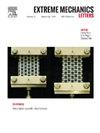Switchable acoustic notch filter using a 3D-printed Helmholtz resonator array with bistable structures
IF 4.5
3区 工程技术
Q2 MATERIALS SCIENCE, MULTIDISCIPLINARY
引用次数: 0
Abstract
Acoustic noise is a significant environmental issue that affects quality of life, including in workplaces. Therefore, the ability to selectively block specific sound frequencies is desired to maintain clear vocal communication. Electrically driven active noise control (ANC) is a common solution. However, its effectiveness is limited to frequencies above 1 kHz. On the other hand, passive noise control (PNC) has gained attention as an alternative solution due to its non-reliance on electricity. Among these, Helmholtz resonators (HRs) have recently attracted interest due to their ability to reduce acoustic noise at their resonant frequencies. Traditional HRs are generally limited to attenuating single frequencies, which restricts their ability to attenuate multiple frequencies using a single device. Herein, we propose an HR featuring a bistable structure that enables switching between two distinct attenuation frequencies. A bistable structure with two stable states allows for switchable configurations that enable volume changes. By integrating this bistable mechanism into an HR chamber, the resonant frequency can be altered by changing the chamber volume. Consequently, the proposed HR can attenuate two different frequencies between the concave and convex states. The proposed system was fabricated using a 3D printer with silicone material, and its bistable properties were evaluated. The measured resonant frequencies were 6.6 kHz in the concave state and 4.1 kHz in the convex state, resulting in dual-frequency noise reduction. In principle, the proposed HR design can be extended to a multi-stable mechanism that enables the attenuation of multiple frequencies.
使用具有双稳结构的3d打印亥姆霍兹谐振器阵列的可切换声学陷波滤波器
噪音是影响生活质量的重要环境问题,包括在工作场所。因此,需要有选择地屏蔽特定声音频率的能力来保持清晰的声音交流。电力驱动的主动噪声控制(ANC)是一种常见的解决方案。然而,它的有效性仅限于1 kHz以上的频率。另一方面,被动噪声控制(PNC)作为一种不依赖电力的替代解决方案而受到关注。其中,亥姆霍兹谐振器(HRs)由于能够在其谐振频率上降低噪声而引起了人们的兴趣。传统的hr通常仅限于衰减单个频率,这限制了它们使用单个设备衰减多个频率的能力。在这里,我们提出了一个具有双稳态结构的HR,可以在两个不同的衰减频率之间切换。具有两个稳定状态的双稳态结构允许可切换的配置,从而支持音量更改。通过将这种双稳态机制集成到HR腔室中,可以通过改变腔室容积来改变谐振频率。因此,所提出的HR可以衰减凹态和凸态之间的两种不同频率。利用硅酮材料3D打印机制作了该系统,并对其双稳态性能进行了评估。在凹态下谐振频率为6.6 kHz,凸态下谐振频率为4.1 kHz,实现了双频降噪。原则上,提出的HR设计可以扩展到多稳定机制,使多个频率的衰减。
本文章由计算机程序翻译,如有差异,请以英文原文为准。
求助全文
约1分钟内获得全文
求助全文
来源期刊

Extreme Mechanics Letters
Engineering-Mechanics of Materials
CiteScore
9.20
自引率
4.30%
发文量
179
审稿时长
45 days
期刊介绍:
Extreme Mechanics Letters (EML) enables rapid communication of research that highlights the role of mechanics in multi-disciplinary areas across materials science, physics, chemistry, biology, medicine and engineering. Emphasis is on the impact, depth and originality of new concepts, methods and observations at the forefront of applied sciences.
 求助内容:
求助内容: 应助结果提醒方式:
应助结果提醒方式:


